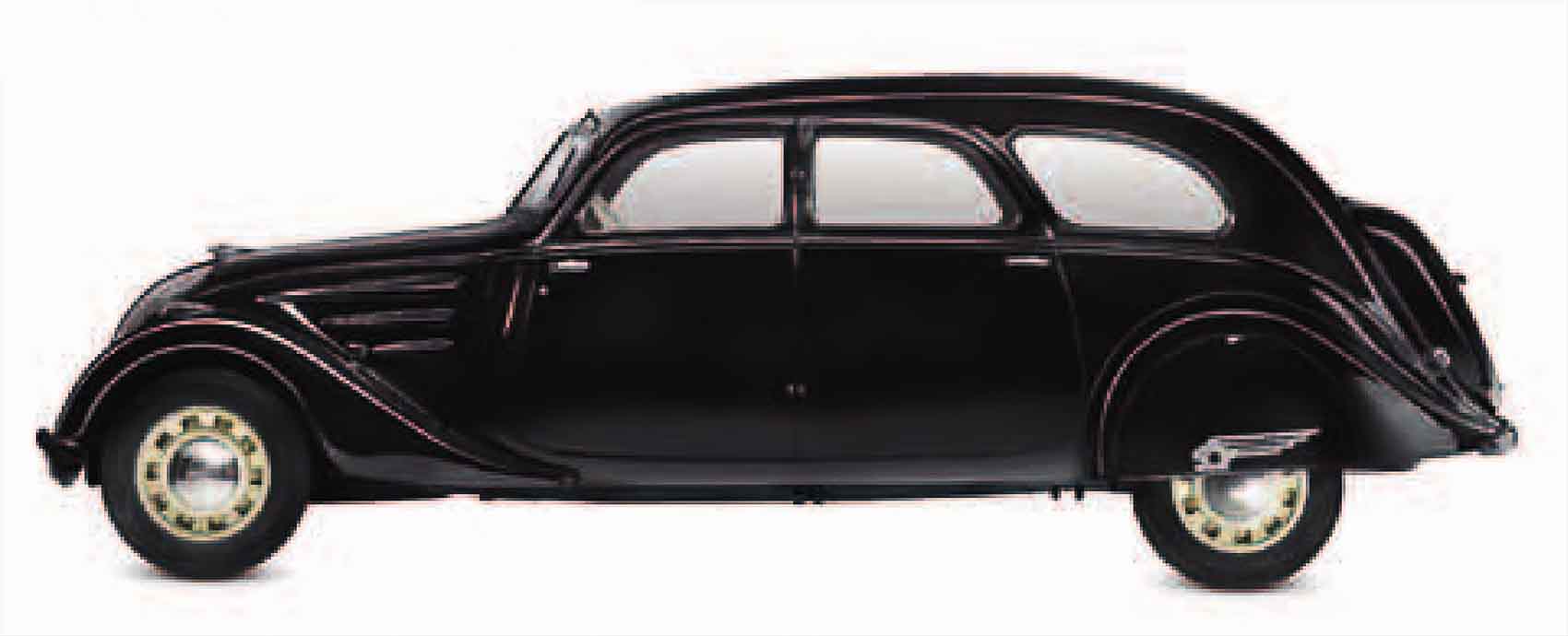
Streamlined Cars
The vast majority of drivers in the 1930s were perfectly happy with their spacious, easily-accessed, upright, slab-fronted cars. But now that cars were capable of comfortably exceeding 80 mph (129 km/h) a small number of stylists and engineers in the United States and Europe were turning their attention to aerodynamics, and exploring its potential to increase maximum speeds dramatically and boost stability.
Pierce Silver Arrow, 1933

| Origin | USA |
| Engine | 7,566 cc, V12 |
| Top speed | 115 mph (185 km/h) |
A concept car designed by James R. Hughes, only five Silver Arrows were built in this form. It caused a sensation at the 1933 New York Show, but was too expensive.
Bugatti Type 50, 1931

| Origin | France |
| Engine | 4,972 cc, straight-eight |
| Top speed | 110 mph (177 km/h) |
Jean Bugatti styled this Profilée coupe with the most extreme raked windshield yet seen on a road car.
Peugeot 402, 1935

| Origin | France |
| Engine | 1,991 cc, straight-four |
| Top speed | 75 mph (121 km/h) |
Far more successful than most streamlined cars of the 1930s, mainly due to its low price, 75,000 of the 402 were sold. Retaining a separate chassis allowed Peugeot to offer 16 body styles.
Cord 810, 1936

| Origin | USA |
| Engine | 4,730 cc, V8 |
| Top speed | 93 mph (150 km/h) |
The wonderful Cord didn’t just boast aerodynamic styling with pop-up headlights: It had front-wheel drive with trailing arm suspension and electric gearshift.
Renault Viva Gran Sport, 1936

| Origin | France |
| Engine | 4,085 cc, straight-six |
| Top speed | 89 mph (143 km/h) |
With its swept-back, V-shaped grille forming part of the body rather than standing vertically, plus laid-back headlights faired into the front wings, this was an advanced car for its time.
Cord Phantom Corsair, 1938

| Origin | USA |
| Engine | 4,730 cc, V8 |
| Top speed | 115 mph (185 km/h) |
Designed by millionaire Rust Heinz and built by California coachbuilders Bohmann & Schwartz, based on a Cord 810, this one-off dream car featured in the 1938 film The Young in Heart.
Alfa Romeo 6C 2300 Aerodinamica, 1935

| Origin | Italy |
| Engine | 2,309 cc, straight-six |
| Top speed | 120 mph (193 km/h) |
Developed secretly on Benito Mussolini’s reguest by Vittorio Jano and Gino and Oscar Jankovits, this car was planned as a V12, but was fitted with a six-cylinder engine.
Alfa Romeo 8C 2900B Le Mans Coupe, 1938

| Origin | Italy |
| Engine | 2,905 cc, straight-eight |
| Top speed | 140 mph (225 km/h) |
This sensational, aerodynamic coupe, driven by Raymond Sommer and Clemente Biondetti, set the fastest lap at 97 mph (156 km/h), and led for 219 laps at the 1938 Le Mans 24-hour race-until a tire blew.
Mercedes-Benz 150H Sport Roadster, 1934

| Origin | Germany |
| Engine | 1,498 cc, straight-four |
| Top speed | 78 mph (125 km/h) |
Designers Hans Nibel and Max Wagner at Mercedes created this mid-engined sports racing prototype, of which just 20 were made. It had great handling and innovative features such as a coil-sprung, swing-axle rear suspension, and disc wheels.
Steyr 50, 1936

| Origin | Germany |
| Engine | 978 cc, straight-four |
| Top speed | 53 mph (85 km/h) |
This teardrop-shaped Austrian people’s car was more powerful than some, so it could climb steep Alpine passes. Some 12,000 Steyr 50s were sold up to 1940.
Tatra T87, 1936

| Origin | Czechoslovakia |
| Engine | 2,968 cc, V8 |
| Top speed | 99 mph (159 km/h) |
With exceptionally aerodynamic bodywork by Paul Jaray and Hans Ledwinka, the rear-engined Tatra was as effective as it was unconventional.
Chrysler CU Airflow Eight, 1934

| Origin | USA |
| Engine | 5,301 cc, straight-eight |
| Top speed | 90 mph (145 km/h) |
With its wind tunnel-developed monocoque body, low build, and great handling, the Airflow was way ahead of its time. But the car suffered quality problems, and its sales were poor.
Lincoln-Zephyr, 1936

| Origin | USA |
| Engine | 4,378 cc, V12 |
| Top speed | 90 mph (145 km/h) |
Faired-in headlights and aerodynamic styling made the monocoque-construction Zephyr look very modern, but it still had a side-valve engine and mechanical brakes.
Lagonda V12 Lancefield Le Mans Coupé, 1939

| Origin | UK |
| Engine | 4,479 cc, V12 |
| Top speed | 128 mph (206 km/h) |
Lagonda improved its fortunes in the 1930s with a superb V12 engine, which powered two roadsters to 3-4 finishes at Le Mans in 1939. This coupe was finished too late to join them.
Panhard et Levassor X77 Dynamic, 1936

| Origin | France |
| Engine | 2,863 cc, straight-six |
| Top speed | 90 mph (145 km/h) |
Despite advanced monocoque construction, torsion-bar independent front suspension, and a near-central driving position, the “Art Deco” Dynamic was not popular.
It is a quote. The Definitive Visual History Of The Automobile 2011




